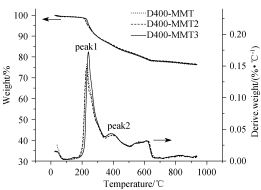1 Pinnavaia, T. J.; Beall, G. W. Polymer-clay Nanocomposites, John Wiley & Sons, Ltd, Chichester, UK, 2000.

2 Wang, X. Q.; Wang, Y. Q.; Zhao, Z. L.; Zhu, X. G.; Nie, C.; Du, S. Y. Chin. J. Chem. 2011, 29, 1278.
3 Lebaron, P. C.; Wang, Z.; Pinnavaia, T. J. Appl. Clay Sci.1999, 15, 11.

4 Alexandre, M.; Dubois, P. Mater. Sci. Eng. 2000, 28, 1.

5 Chen, K. H.; Yang, S. M. Appl. Polym. Sci. 2002, 86, 414.

6 Becker, O.; Varley, R.; Simona, G. Polymer 2002, 43, 4365.

7 Qi, Z.-N.; Shang, W.-Y. Theory and Practice of Polymer/ Layered Silicate Nanocomposite, Chemical Industry Press of China, Beijing, 2002, p. 28 (in Chinese). (漆宗能, 尚文宇, 聚合物/层状硅酸盐纳米复合材料理 论与实践, 化学工业出版社, 北京, 2002, p. 28.)

8 Feng, M.; Zhao, C.-G.; Gong, F.-L.; Yang, M.-S. Acta Chim. Sinica 2004, 62, 83 (in Chinese). (冯猛, 赵春贵, 巩方玲, 阳明书, 化学学报, 2004, 62,83.)
9 Wang, N.; Miao, D.; Li, H.-W.; Fang, Q.-H.; Chen, E.-F. Acta Chim. Sinica 2010, 68, 2356 (in Chinese). (王娜, 苗頔, 李洪伟, 方庆红, 陈尔凡, 化学学报, 2010,68, 2356.)
10 Giannelis, E. P. Adv. Mater. 1996, 8, 29.

11 Fu, X.; Qutubuddin, S. Polymer 2001, 42, 807.

12 Lin, J. J.; Chen, I. J.; Wang, R.; Lee, R. J. Macromolecules2001, 34, 8832.

13 Wang, Y. Q.; Wang, X. Q.; Duan, Y. F.; Liu, Y. Z.; Du, S. Y. Clays Clay Miner. 2011, 59, 507.

14 Lin, J. J.; Cheng, I. J.; Chu, C. C. Polym. J. 2003, 35, 411.
15 Chiu, C. W.; Chu, C. C.; Cheng, W. T.; Lin, J. J. Eur. Polym. J. 2008, 44, 628.
16 Salahuddin, N. A. Polym. Adv. Technol. 2004, 15, 251.

17 Wang, S.-Z.; Zang, X.-S. Modern Research Methods of Materials, Beihang University Press, Beijing, 1991 (in Chinese). (王世中, 藏鑫士, 现代材料研究方法, 北京航空航天大 学出版社, 北京, 1991.)

18 Li, Q.; Li, Z. Acta Chim. Sinica 2004, 62, 1409 (in Chinese). (李强, 李钟, 化学学报, 2004, 62, 1409.)














